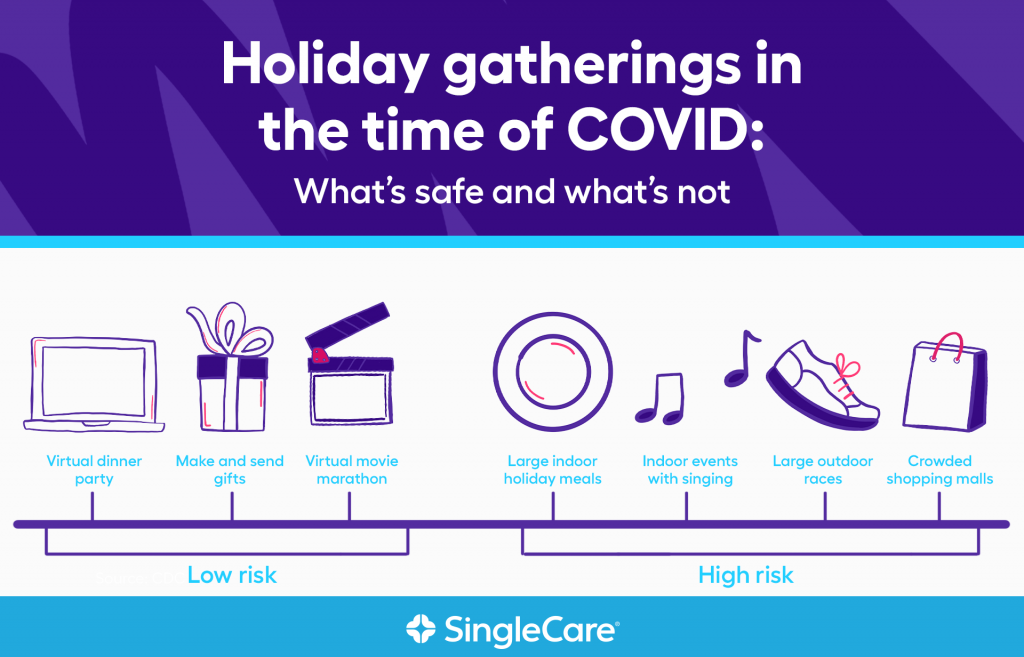A crowd of out-of-state family members gathered round the Thanksgiving table? A December calendar filled with cookie swaps and holiday mixers? An annual Hanukkah sufganiyot-making party with the neighborhood kids? Hold that thought.
There’s no question that the holidays will be different this year. Just like pretty much every other aspect of our daily lives, COVID-19 is making us second-guess our holidays—from travel plans to family traditions. Of course, safety should be top of mind: a potentially deadly virus makes a lousy holiday souvenir. And particularly for multigenerational gatherings, elderly and immunocompromised family and friends shoulder a greater risk when large groups gather, says Mike Dean, MD, a family physician in Chicago.
Still, there’s a false binary in thinking that you can either proceed with your usual holiday plans or stay home solo and sulk, says Aaron Carrol, MD, a professor of pediatrics at Indiana University School. Instead, “consider each holiday and ask yourself ‘how can I make this as safe as possible?’” A family buffet for 40 might be on the do-not-do list, but there are still ways to celebrate with loved ones this holiday season.
RELATED: Survival tips for dealing with holiday depression
How to determine your risk
Not every in-person gathering during COVID-19 carries the same amount of risk. The U.S. Centers for Disease Control and Prevention (CDC) recently released guidelines to help people assess the risks of various activities into low, medium, and high-risk categories.
But it’s important to note that location also plays a big factor: If you’re in an area where coronavirus cases are rising or local officials have imposed more COVID-19 gathering restrictions to help limit the spread, it might be safest to move festivities online or severely curb the number of people at your event. On the other hand, if you’re in an area where COVID cases are well-contained and your family lives nearby, gathering may pose less of a risk. Before sending out invites or making firm plans, it’s always worth checking with your local health department website for up-to-date information.

RELATED: How to handle holiday stress
Low risk holiday activities
The best way to limit the spread of COVID-19 and avoid the virus is to celebrate only with your immediate family. That doesn’t have to mean that others are left out entirely though. You could try hosting a virtual dinner party, so your kids can chat with grandma or sing carols with their cousins from a safe distance.
Making and sending presents—whether that’s turkey-shaped cookies for Thanksgiving or handmade ornaments for Christmas—is another way to feel connected, without actually coming in contact. For those friends and family who live nearby, you could even do a curbside drop-off and chat at a safe distance. (Keep in mind: The CDC recommends wearing face masks around others and maintaining at least six feet of space.)
Another option is to host a virtual movie marathon, where friends and families at different locations all watch in unison. If you’re fans of Netflix or Disney, Teleparty is a free app that synchronizes streaming and supports group chat functions.
Moderate risk holiday activities
It’s hard to make a blanket rule that all family meals are dangerous or all outdoor activities are safe, says Dr. Dean. Whenever you intend to gather beyond your immediate family, the CDC recommends considering these factors:
- Location: Studies show that indoor gatherings during COVID-19 generally pose a higher risk than outdoor gatherings.
- Duration: A four-hour event means more time to interact with people who could be carrying the virus, compared with a one-hour event. In general, the shorter the duration the lower the risk.
- Number of people: The more family and friends that gather together, the more risk that’s created. Keeping gatherings small this year limits that risk.
- Where people are from: If you have family or friends traveling from a community with higher rates of COVID-19, seeing them poses a greater risk.
- Behaviors: Activities in which people can wear masks, maintain social distance, and keep their hands clean are far less risky than those where people are in close proximity and without masks.
Almost any gathering can be made less risky by tweaking one or more of these factors, Dean says. Let’s say you typically gather 20 of your nearest and dearest for a pie-baking bonanza the day before Thanksgiving. This year, could you limit your kitchen helpers to just three or four friends? Could you have everyone bake at home and then gather in the backyard to swap slices to be eaten later? Would everyone feel comfortable cooking with masks and keeping the kitchen windows open? None of those changes alone is going to limit the spread of COVID-19 completely, but each change makes the holiday activity safer while still allowing you to celebrate with loved ones.
High-risk holiday activities
Any holiday activities that involve gathering large crowds indoors and unmasked for long periods of time are higher risk. We know that pretty much describes the typical holiday feast to a T! But if you do decide to invite extended family (especially from a wide geographic area) over for a lengthy meal and let everyone linger indoors, know that you’re assuming a sizable risk compared with other activities.
The CDC warns that other high-risk holiday activities include attending crowded parades, going shopping in crowded malls, participating or being a spectator at a crowded race (sorry, turkey trotters!), and attending indoor celebrations with singing or chanting. And while alcohol alone doesn’t increase the risk of contracting COVID, know that it can cloud your judgment and make it harder to stay vigilant when it comes to social distancing, handwashing, and wearing a mask.











